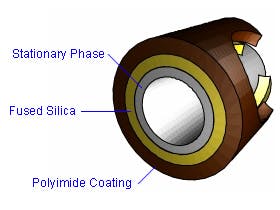
Agilent J&W Column Selection Principles

There are four major column parameters to consider:
- Stationary phase: match it to the polarity of your analyte
- Diameter: it depents on the size of your sample
- Length: to increase the resolution when needed
- Thickness: it depends on the volatility of your sample
Stationary Phase Selection Summary
- If no information or ideas about which stationary phase to use is available, start with a
DB-1 or DB-5. - Low bleed ("ms") columns are usually more inert and have higher temperature limits.
- Use the least polar stationary phase that provides satisfactory resolution and analysis times. Non-polar stationary phases have superior lifetimes compared to polar phases.
- Use a stationary phase with a polarity similar to that of the solutes. This approach works more times than not; however, the best stationary phase is not always found using this technique.
- If poorly separated solutes possess different dipoles or hydrogen bonding strengths, change to a stationary phase with a different amount (not necessarily more) of the dipole or hydrogen bonding interaction. Other co-elutions may occur upon changing the stationary phase, thus the new stationary phase may not provide better overall resolution.
- If possible, avoid using a stationary phase that contains a functionality that generates a large response with a selective detector. For example, cyanopropyl containing stationary phases exhibit a disproportionately large baseline rise (due to column bleed) with NPDs.
- A DB-1 or DB-5, DB-1701, DB-17, and DB-WAX cover the widest range of selectivities with the smallest number columns.
- PLOT columns are used for the analysis of gaseous samples at above ambient column temperatures.
Column Diameter Selection Summary
- Use 0.18-0.25 mm I.D. columns when higher column efficiencies are needed. 0.18 mm I.D. columns are especially well suited for GC/MS systems with low pumping capacities. Smaller diameter columns have the lowest capacities and require the highest head pressures.
- Use 0.32 mm I.D. columns when higher sample capacity is needed. They often provide better resolution of earlier eluting solutes for splitless injections or large injection volumes (>2 µL) than 0.25 mm I.D. columns.
- Use 0.45 mm I.D. columns when only a Megabore direct injector is available and higher column efficiency is desired. Well suited for high carrier gas flow rate situations such as with purge & trap, headspace samplers, and valve injection applications.
- Use 0.53 mm I.D. columns when only a Megabore direct injector is available. Well suited for high carrier gas flow rate situations such as with purge & trap and headspace samplers. 0.53 mm I.D. columns have the highest sample capacities at constant df.
Column Length Selection Summary
- Start with 25-30 meter columns when the best length is unknown.
- 10-15 meter columns are well suited for samples containing very well separated solutes or very few solutes. Shorter lengths are used for very small diameter columns to reduce head pressures.
- 50-60 meter columns should be used when resolution is not possible by other means (smaller diameter, different stationary phase, change in column temperature). Best suited for complex samples containing a large number of solutes. Long columns have long analysis times and higher cost.
Column Film Thickness Selection Summary
- For 0.18-0.32 mm I.D. columns, a film thickness of 0.18-0.25 µm is average or standard (i.e., not thin or thick) and used for most analyses.
- For 0.45-0.53 mm I.D. columns, a film thickness of 0.8-1.5 µm is average or standard (i.e., not thin or thick) and used for most analyses.
- Thick film columns are used to retain and resolve volatile solutes (e.g., light solvents, gases). Thick columns are more inert and have higher capacities. Thick film columns exhibit higher column bleed and decreased upper temperature limits.
- Thin film columns are used to minimize the retention of high boiling, high molecular weight solutes (e.g., steroids, triglycerides). Thin film columns are less inert, have lower capacities and exhibit lower column bleed.
